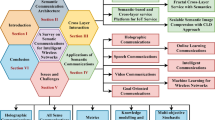Abstract
We introduced the use of two-hop forwarding to increase the throughput of an 802.11 network in our earlier work (Narayanan et al., Proceedings of IEEE WCNC’05, March 2005). Other researchers have also considered the benefits of forwarding in the 802.11 infrastructure mode to increase the total network throughput. But the high-data rate node that forwards data for other nodes will have to spend its energy transmitting this data. Previous work on forwarding implicitly assumed that in an enterprise network, the collective good is sufficient to justify this increased energy expense. However, it is important to address the advantages and the cost of participating in such schemes from the individual forwarding node’s perspective. Since a node cannot know whether there are other high-data rate nodes in the network capable and willing to forward data, it needs to assume that it is the only node with the capability to do so. In this paper, we focus our analysis on the cost benefit for such a forwarding node. We quantify the throughput improvement, medium access delay reduction and energy consumption for the forwarding node in a saturated network. The analysis and simulation results demonstrate that in a saturated network, participation in forwarding provides the high-data rate node with significant benefits in throughput and media-access-delay, while increasing the number of bits-per-joule even if it is the only node participating in data forwarding as suggested in this paper. The increase in the bits-per-joule is due to the reduction in the total amount of time needed by the high data rate node to transmit a given number of its own application bits. This results in savings in energy expenditure for the forwarding node. Based on these benefits, we conclude that it is unequivocally in the interest of a high data rate node to participate in two-hop forwarding schemes in 802.11 networks.
Similar content being viewed by others
References
Sathya Narayanan, Pei Liu, and Shivendra Panwar, “On the advantages of multi-hop extensions to IEEE 802.11 infrastructure mode”, Proc. of IEEE WCNC’05, March 2005.
Sathya Narayanan, and Shivendra Panwar, “When two-hop meets VoFi”, Proc. of CCNC 2006, January 2006.
P. Liu, Z. Tao, and S. Panwar, “A cooperative MAC protocol for wireless local area networks”, Proc. of IEEE ICC’05, June 2005.
P. Liu, Z. Tao, S. Narayanan, T. Korakis, and S. Panwar, “CoopMAC: A cooperative MAC for wireless LANs”, to appear in IEEE Journal on Selected Areas in Communications, special issue on Cooperative Communications and Networking.
Sathya Narayanan, Pei Liu, and Shivendra Panwar, “On the advantages of multi-hop extensions to IEEE 802.11 infrastructure mode”, New York Metro Area Networking Workshop, September 2004.
H. Zhu and G. Cao, “rDCF: A Relay-enabled Medium Access Control Protocol for Wireless Ad Hoc Networks”, Proc. of IEEE Infocom, March 2005.
Omer Ileri, Siun-Chuon Mau, and Narayan B. Mandayam, “Pricing for enabling forwarding in self-configuring ad hoc networks”, IEEE Journal on Selected Areas in Communications, Vol. 23, No. 1, January 2005.
IEEE 802.11, “Wireless LAN Medium Access Control (MAC) and Physical layer (PHY) Specifications”, Standard, IEEE, Aug 1999.
IEEE 802.11b, Part 11: “Wireless LAN Medium Access Control (MAC) and Physical layer (PHY) specifications: High-Speed Physical layer Extension in the 2.4 GHz Band”, supplement to IEEE 802.11 Standard, Sept. 1999.
IEEE 802.11g, Part 11: “Wireless LAN Medium Access Control (MAC) and Physical Layer (PHY) specifications”, Amendment 4: Further Higher-Speed Physical Layer Extension in the 2.4 GHz Band, June 2003.
Giuseppe Bianchi, “Performance analysis of the IEEE 802.11 Distributed Coordination Function”, IEEE Journal on Selected Areas in Communications, Vol.18, No.3, March 2000.
Martin Heusse, Franck Rousseau, Gilles Berger-Sabbatel, and Andrzej Duda, “Performance anomaly of 802.11b” Proc. of IEEE INFOCOM’03.
P. Chatzimisios, A.C. Boucouvalas, and V. Vitsas, “IEEE 802.11 Packet delay–A finite retry limit analysis”, Proc. of IEEE Globecom’03, December 2003.
Marcelo M. Carvalho, Cintia B. Margi, Katia Obraczka, and J.J. Garcia-Luna-Aceves, “Modeling energy consumption in single-hop IEEE 802.11 Ad Hoc Networks”, Proc. of ICCCN’04, October 2004.
Ramesh Karri, and Piyush Mishra, “Optimizing IPSEC for energy efficient secure wireless sessions”, WICAT Technical report - TR-02-003, Polytechnic University, April 2002.
L.M. Feeney and M. Nilsson, “Investigating the energy consumption of a wireless network interface in an ad hoc networking environment”, Proc. of IEEE INFOCOM’01, April 2001.
Author information
Authors and Affiliations
Corresponding author
Rights and permissions
About this article
Cite this article
Narayanan, S., Panwar, S.S. To Forward or not to Forward – that is the Question. Wireless Pers Commun 43, 65–87 (2007). https://doi.org/10.1007/s11277-006-9239-y
Received:
Accepted:
Published:
Issue Date:
DOI: https://doi.org/10.1007/s11277-006-9239-y




